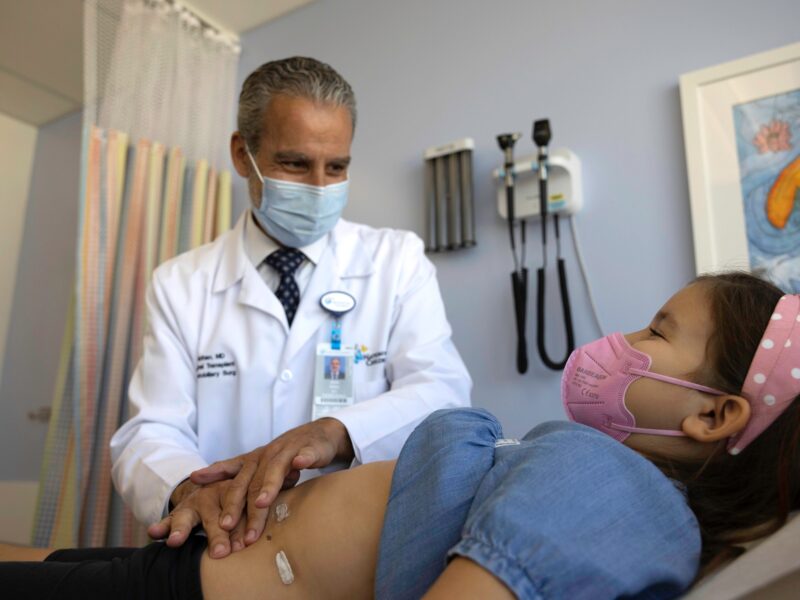Probing for Links Between Psychotropic Drugs and Severe Liver Disease
Probing for Links Between Psychotropic Drugs and Severe Liver Disease https://pediatricsnationwide.org/wp-content/themes/corpus/images/empty/thumbnail.jpg 150 150 Kevin Mayhood Kevin Mayhood https://secure.gravatar.com/avatar/bd57a8b155725b653da0c499ae1bf402?s=96&d=mm&r=g- January 05, 2015
- Kevin Mayhood
Drugs that help minors with severe mental health disorders may put overweight and obese patients at risk for severe liver disease.
In a paper that appears to be the first to suggest the connection, the authors point out that youths who suffer from psychiatric illnesses are already at greater risk for obesity and its comorbidities. An earlier study led by one of the authors found that more than half of children with mood disorders are overweight, 30 percent of them obese.
For some, the psychotropic drugs they’re prescribed spark rapid weight gain, alter metabolism to increase plasma triglycerides, or both. Either can contribute to nonalcoholic fatty liver disease.
Referred to as NAFLD, the disease is now a worldwide epidemic. Nearly 30 percent of adults and 9 percent of children suffer from NAFLD, with a higher percentage reported among obese children. Left undiagnosed or untreated, the disease can progress to nonalcoholic steatohepatitis (NASH), a more aggressive form, with fibrosis and cirrhosis of the liver.
“Because obesity has become more prevalent, the number of liver biopsies done in obese kids with fatty liver has increased every year,” says Carol Potter, MD, a pediatric gastroenterologist at Nationwide Children’s and coauthor of the study.
After testing a series of patients who had behavioral issues and were on medications that caused them to gain weight rapidly, Dr. Potter began looking into a link. “When we did liver biopsies, they seemed to have much worse liver disease than we would expect,” she says.
Dr. Potter contacted Barbara Gracious, MD, a psychiatrist and principal investigator in the Center for Innovation in Pediatric Practice in The Research Institute at Nationwide Children’s, who had referred patients to the hospital’s Division of Gastroenterology, Hepatology and Nutrition. They searched the medical literature, finding no links between psychotropic medications and severe liver disease.
But they found two cases showing possible connections.
In the first case, a 17-year-old girl diagnosed with bipolar disorder Type I suffered from ongoing major depression, trouble concentrating, and social and educational problems. She was overweight when she first came to the hospital. Over the next 18 months she gained weight steadily as she became less physically active (due to the severity of her symptoms), took psychotropic medications that boosted her appetite and ate high-calorie foods to cope with stressors.
Lab tests for liver function and damage steadily worsened. A liver biopsy showed she had NASH and fibrosis of the liver edging toward cirrhosis.
In a second case, a 17-year-old boy who had obsessive compulsive disorder and oppositional defiant disorder was treated with two psychotropic medications for 14 months and a third for eight months. During that time, he gained about 10 pounds, his BMI rose to the 98.7th percentile and biomarkers of liver damage rose above normal.
The boy’s family asked to discontinue two of the drugs suspected of contributing to the physical changes. After a month, the biomarkers decreased, eventually reaching normal levels. A liver biopsy showed the presence of steatosis, the benign form of NALFD.
“One only finds these cases if they check liver function tests, which are not routinely done in youth taking atypical antipsychotic medications,” says Dr. Gracious, lead author of the study. She was surprised and very concerned by the girl’s rapid changes in liver function and structure at such a young age.
“Kids who are on medications that make them gain weight rapidly and change some of their metabolic pathways are at higher risk and need to be watched carefully,” says Dr. Potter, who is also an associate professor of Clinical Pediatrics at The Ohio State University College of Medicine. “We need to recognize that nonalcoholic fatty liver disease is common in kids, and it can be very severe. You can have cirrhosis in a 6-year-old, but you won’t see it if you don’t look for it.”
The authors suggest new steps for children taking medications that lead to weight gain and metabolic changes. They recommend that those children with a BMI above the 85th percentile have a twice-yearly fasting lipid profile (to check their cholesterol and triglyceride levels) and fasting glucose and liver function tests. Patients with elevated levels of liver enzymes alanine transaminase (ALT) or aspartate transaminase (AST) should receive a liver ultrasound.
If the ultrasound is abnormal with fatty liver or enlarged spleen, or if AST or ALT is elevated past normal limits for one to three months, the doctors recommend the patient be referred to a pediatric gastroenterology specialist.
The researchers are now reviewing several years’ worth of records for overweight and obese minors who had liver biopsies, in an attempt to determine if those on psychotropic medications were more likely to have steatohepatitis and fibrosis. They hope to complete and publish the study late next year.
Reference:
Gracious BL, Bhatt R, Potter C. Nonalcoholic fatty liver disease and fibrosis in youth taking psychotropic medications: literature review, case reports, and management. Journal of Child and Adolescent Psychopharmacology. 2015 Oct;25(8):602-10.
About the author
-
Kevin Mayhoodhttps://pediatricsnationwide.org/author/kevin-mayhood/April 25, 2015
-
Kevin Mayhoodhttps://pediatricsnationwide.org/author/kevin-mayhood/April 25, 2015
-
Kevin Mayhoodhttps://pediatricsnationwide.org/author/kevin-mayhood/April 25, 2015
-
Kevin Mayhoodhttps://pediatricsnationwide.org/author/kevin-mayhood/October 23, 2015
- Posted In:
- In Brief






